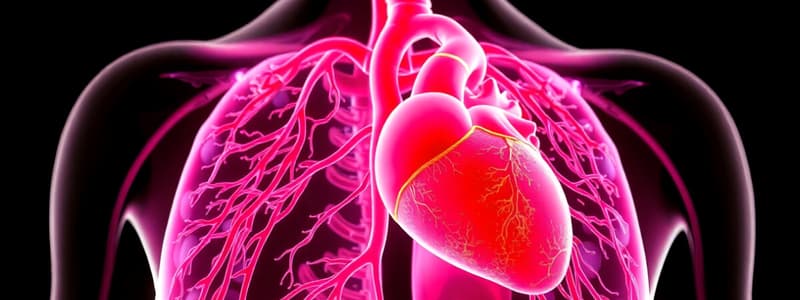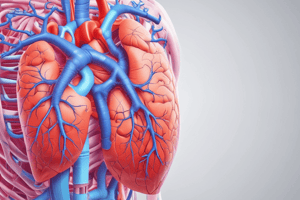Podcast
Questions and Answers
How does recruitment and distention of pulmonary vessels affect calculated pulmonary vascular resistance?
How does recruitment and distention of pulmonary vessels affect calculated pulmonary vascular resistance?
- It leads to an immediate blockage of blood flow to the lungs.
- It has no effect on resistance as resistance remains constant.
- It decreases resistance due to the parallel arrangement of capillaries. (correct)
- It increases resistance significantly due to greater vessel length.
What role does lung volume have on pulmonary vascular resistance?
What role does lung volume have on pulmonary vascular resistance?
- Pulmonary resistance is unaltered by changes in lung volume.
- Narrowing of capillaries occurs at increased alveolar pressure, affecting resistance. (correct)
- Decreases resistance at low lung volumes only.
- Increases resistance regardless of lung volume.
What occurs to extra alveolar vessels during inspiration?
What occurs to extra alveolar vessels during inspiration?
- They remain unchanged regardless of lung volume changes.
- They constrict due to increased intrapleural pressure.
- They initiate blood flow redistribution towards the alveoli.
- They expand as intrapleural pressure becomes more negative. (correct)
How does gravity influence blood flow through the pulmonary circulation?
How does gravity influence blood flow through the pulmonary circulation?
What is the effect of high pulmonary vasculature pressures on capillaries?
What is the effect of high pulmonary vasculature pressures on capillaries?
What characteristic distinguishes the blood carried by the pulmonary artery from that carried by systemic arteries?
What characteristic distinguishes the blood carried by the pulmonary artery from that carried by systemic arteries?
Which factor most directly influences pulmonary vascular resistance when cardiac output increases?
Which factor most directly influences pulmonary vascular resistance when cardiac output increases?
How does hypoxia influence pulmonary blood flow distribution?
How does hypoxia influence pulmonary blood flow distribution?
Which statement correctly describes the compliance of pulmonary blood vessels?
Which statement correctly describes the compliance of pulmonary blood vessels?
What role does the diaphragm play in pulmonary blood flow?
What role does the diaphragm play in pulmonary blood flow?
Which component primarily regulates pulmonary blood flow through vasoactive substances?
Which component primarily regulates pulmonary blood flow through vasoactive substances?
Which mechanism is responsible for the decreasing resistance in pulmonary blood vessels during inhalation?
Which mechanism is responsible for the decreasing resistance in pulmonary blood vessels during inhalation?
How does lung volume affect pulmonary vascular resistance?
How does lung volume affect pulmonary vascular resistance?
What distinguishes pulmonary veins from systemic veins in terms of blood composition?
What distinguishes pulmonary veins from systemic veins in terms of blood composition?
Which characteristic is NOT true of pulmonary circulation compared to systemic circulation?
Which characteristic is NOT true of pulmonary circulation compared to systemic circulation?
What percentage of cardiac output is received by bronchial circulation from the left heart?
What percentage of cardiac output is received by bronchial circulation from the left heart?
From which arteries do bronchial arteries typically arise?
From which arteries do bronchial arteries typically arise?
How does bronchial circulation drain its venous blood?
How does bronchial circulation drain its venous blood?
Which function is NOT associated with the pulmonary blood flow?
Which function is NOT associated with the pulmonary blood flow?
What is the role of the bronchopulmonary circulation?
What is the role of the bronchopulmonary circulation?
Which statement does NOT accurately describe pulmonary blood flow?
Which statement does NOT accurately describe pulmonary blood flow?
What happens to a portion of bronchial capillary blood?
What happens to a portion of bronchial capillary blood?
What best describes the compliance of the pulmonary system compared to systemic circulation?
What best describes the compliance of the pulmonary system compared to systemic circulation?
What effect does the first breath have on the alveoli and pulmonary blood flow?
What effect does the first breath have on the alveoli and pulmonary blood flow?
Which type of nerve fibers innervate the pulmonary arteries and veins?
Which type of nerve fibers innervate the pulmonary arteries and veins?
What is the relationship between pulmonary vascular resistance and blood flow or left atrial pressure?
What is the relationship between pulmonary vascular resistance and blood flow or left atrial pressure?
What underlying mechanism contributes to the decrease in pulmonary vascular resistance with increased blood flow?
What underlying mechanism contributes to the decrease in pulmonary vascular resistance with increased blood flow?
Which of the following statements is true regarding the innervation of pulmonary vessels across different species?
Which of the following statements is true regarding the innervation of pulmonary vessels across different species?
How do humoral substances affect pulmonary vascular smooth muscle?
How do humoral substances affect pulmonary vascular smooth muscle?
What is one consequence of increased pulmonary blood flow?
What is one consequence of increased pulmonary blood flow?
In the context of pulmonary vasculature, what role do vasoactive substances play?
In the context of pulmonary vasculature, what role do vasoactive substances play?
Which factor does NOT influence pulmonary blood flow?
Which factor does NOT influence pulmonary blood flow?
How does pulmonary arterial pressure respond to increases in blood flow?
How does pulmonary arterial pressure respond to increases in blood flow?
What role do pulmonary microvessels play in the filtration of blood?
What role do pulmonary microvessels play in the filtration of blood?
What potential consequences can result from emboli entering systemic circulation?
What potential consequences can result from emboli entering systemic circulation?
How do trap foreign particles in pulmonary vessels affect gas exchange?
How do trap foreign particles in pulmonary vessels affect gas exchange?
What mechanism is involved in the removal of trapped emboli from pulmonary vessels?
What mechanism is involved in the removal of trapped emboli from pulmonary vessels?
What function does the pulmonary circulation serve during periods of increased left ventricular output?
What function does the pulmonary circulation serve during periods of increased left ventricular output?
What is the relationship between pulmonary circulation and cardiac output?
What is the relationship between pulmonary circulation and cardiac output?
Which type of cells in the lung vasculature are primarily responsible for the metabolic conversion of circulating substances?
Which type of cells in the lung vasculature are primarily responsible for the metabolic conversion of circulating substances?
What is a significant feature of pulmonary vessels that contributes to their function?
What is a significant feature of pulmonary vessels that contributes to their function?
Which of these describes the role of biologically active compounds released by lung vascular cells?
Which of these describes the role of biologically active compounds released by lung vascular cells?
Which statement best reflects the relationship between systemic circulation and pulmonary emboli?
Which statement best reflects the relationship between systemic circulation and pulmonary emboli?
Flashcards are hidden until you start studying
Study Notes
Pulmonary and Bronchial Circulation
- Pulmonary circulation perfuses the alveoli for gas exchange, while bronchial circulation provides nutrients and gas exchange for conducting airways
- Bronchial circulation is part of the systemic circulation, receives 2% of cardiac output from left heart
- Bronchial arteries originate from branches of aorta, intercostal, subclavian, or internal mammary arteries
- Bronchial arteries supply tracheobronchial tree with nutrients and oxygen
- Blood pressure in bronchial circulation is similar to other systemic vascular beds
- About a third of bronchial venous drainage is via azygos, hemiazygos, and intercostal veins
- About 2/3 of bronchial capillary blood drains into anastomoses that empty into pulmonary veins
- This connection between bronchial and pulmonary circulation is called the bronchopulmonary circulation
- The bronchopulmonary circulation adds a small volume of poorly oxygenated bronchial venous blood to the freshly oxygenated blood in the pulmonary vein
Functions of Pulmonary Blood Flow
- Pulmonary circulation facilitates gas exchange in the alveoli
- Pulmonary circulation serves as a blood filter, capturing foreign material that could harm systemic vessels
- Pulmonary circulation acts as a blood reservoir for the left ventricle, accommodating around 500 ml of blood
- Pulmonary circulation metabolizes circulating substances, particularly through endothelial cells lining the vessels' lumen
Factors that Regulate Pulmonary Blood Flow
- Hypoxia: Low oxygen levels lead to vasoconstriction, redirecting blood flow to better ventilated areas
- Motor Innervation: Pulmonary veins and arteries have cholinergic and adrenergic innervation, influencing vascular tone
- Vasoactive Substances: Humoral substances in the circulation or produced by lung endothelial cells can cause vasoconstriction or dilation, affecting pulmonary vascular resistance
- Recruitment and Distention: Increased blood flow or left atrial pressure leads to capillary recruitment and distention, decreasing pulmonary vascular resistance
- Hematocrit: High hematocrit can increase pulmonary vascular resistance
- Lung Volume: Pulmonary vascular resistance is lowest at Functional Residual Capacity (FRC) and increases at both high and low lung volumes
- Gravity: Gravity impacts blood flow distribution, with blood flow being higher at the base of the lungs due to gravitational force
Pulmonary Blood Flow Changes with Lung Volume
- Alveolar Vessels: Compressed during inspiration, increasing resistance to blood flow
- Extra-Alveolar Vessels: Dilate during inspiration due to decreasing intrathoracic pressure, reducing resistance to blood flow
Hypoxic Pulmonary Vasoconstriction
- Hypoxia causes vasoconstriction in poorly ventilated areas, diverting blood flow to better ventilated areas
- This mechanism optimizes gas exchange by ensuring that blood flows to areas where oxygen uptake is most efficient
Studying That Suits You
Use AI to generate personalized quizzes and flashcards to suit your learning preferences.




